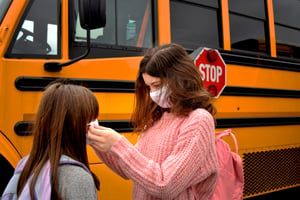Helping Special Needs Students Adapt to COVID-19 Safety Requirements
published on March 19, 2021 by Sonia Mastros
Student Safety, school bus safety, school bus safety plans
 Transporting special needs students always has some additional challenges, and that's especially true during the coronavirus pandemic. School bus drivers and transportation directors need to be making concerted efforts to help special needs children maintain safety protocols.
Transporting special needs students always has some additional challenges, and that's especially true during the coronavirus pandemic. School bus drivers and transportation directors need to be making concerted efforts to help special needs children maintain safety protocols.
Every student's situation will be a little different, but we have some suggestions that may help in ensuring that proper safety procedures are followed by all students.
Five Ways To Accommodate Special Needs Students While Following COVID-19 Safety Procedures
1. Work With Your Special Ed Department
No one will be more informed about the needs and personalities of these students than the special ed teachers who work with them daily. Their input will be invaluable in helping to craft procedures that will accommodate the special needs students' special cases. You might even consider bringing them along on the bus as assistants if it's feasible.
2. Use Modeling To Improve Mask-Wearing
Many special needs students respond well to modeling when trying to modify their behavior. Be sure everyone who works with them is wearing a mask properly, especially anyone the student may look up to like siblings or favorite teachers. Using dolls or stuffed animals to model mask-wearing may also help.
3. Keep Parents Involved
Parents may be your best allies when working with special needs students. Schedule a conference where you outline the school bus safety procedures, so the child's parents understand the situation. Then they can help reinforce the behaviors that special needs students will be expected to follow while on the bus.
4. Have Adults Practice Working With Wheelchairs, Harnesses, and Similar Restraining Devices
Students in wheelchairs or those with other mobility issues will need help getting strapped into place, and this will inevitably mean having an adult in close contact. However, this contact should still be minimized as much as possible. Practicing with the harnesses and restraints ahead of time will let them safely secure the child as quickly as possible.
5. Consider Running Separate Vans for Those Who Cannot Adapt
Some special needs students may simply be unable to follow the necessary guidelines or have physical conditions - such as breathing problems - that legitimately limit their use of masks. In these cases, running those students in separate vehicles may be the best option. Your drivers can drive with beefed-up PPE, such as wearing N-95 masks, to help protect them while driving the students around.
There's no 'magic bullet' for helping special needs students adapt to these difficult times. Every situation will be a bit different.
However, has your district found any particularly effective ways of keeping special needs students safe and healthy during the lockdown? If so, please share your tips in the comments below!



